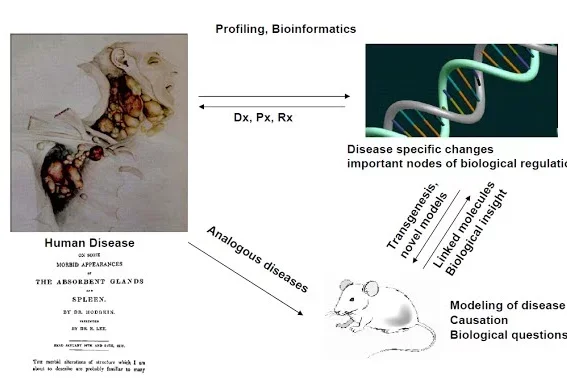Research
Overview
We are a translational research laboratory interested in basic mechanisms of development and oncogenesis in the hematolymphoid system. A central question in our research is how non-traditional mechanisms of gene regulation effect fundamental aspects of development and how these mechanisms go awry in cancer. Our research program spans the spectrum from discovery of these novel regulators in disease states to understanding their biological significance to developing rational therapeutic approaches to these diseases.

Current Projects
RNA-binding proteins in leukemia and cancer
Gene expression is a finely tuned, intricate process that normally regulates cellular identity, and becomes disrupted in cancer. A relatively new addition to the repertoire of gene expression regulatory molecules are the so-called RNA binding proteins, defined as proteins whose function is to bind ribonucleic acids (RNA). These proteins participate in gene expression by binding to and regulating messenger RNA (mRNAs), which in turn are translated into proteins. In our lab, we identified that one particular RNA-binding protein, IGF2BP3, was responsible for driving a highly aggressive leukemia, based on patient materials, cell lines, and mouse models. Additionally, IGF2BP3 is not necessary for normal homeostatic development in the mouse, rendering it a cancer-specific target. Through domain-mapping experiments and high throughput characterization of IGF2BP3 binding sites in mRNA, we determined that RNA-binding is necessary for the function of this protein. Hence, we have discovered a major, cancer-specific gene regulatory mechanism, which involves the direct binding of IGF2BP3 to specific mRNAs. Current work involves, first, understanding the molecular mechanisms that underlie the specificity of binding and downstream effects on gene expression. Second, the impact of disrupting these mechanisms in leukemogenesis are a second major scientific focus of the laboratory. Third, we are interested in developing translational approaches to interfere with IGF2BP3 function for future therapeutic intervention. Fourth, we have active collaborations with groups studying pancreatic cancer, brain cancer and soft tissue tumors, to explore roles of IGF2BP3 in these many types of hematologic malignancy.
microRNA in hematopoiesis and hematologic malignancy
MicroRNAs are small non-coding RNA molecules that are critical in physiology and pathology. Their function is based on their sequence homology-based binding to and regulation of mRNA targets, thereby modulating gene expression. Over the last decade, we have studied a number of microRNAs, including miR-34a, miR-146a, and miR-155. Current projects in the lab include understanding the role of miR-146a in the immune response. We have recently published a paper on defective marginal zone B-cell development in miR-146a deficient mice, and collaborated on a manuscript that describes roles for miR-146a in regulating T-cell activation. Studies of how miR-146a regulates B-cell activation and autoimmunity are future focuses of this area of research in the laboratory. miR-155 is a bona fide oncogenic microRNA that has functions in acute myeloid leukemia, particularly those with FLT3-ITD mutations. Ongoing work in the lab is focused on understanding the roles of miR-155 in leukemic stem cells and how this might be leveraged to develop novel therapeutic approaches to this subtype of AML.
Long non-coding RNA in hematopoiesis and hematologic malignancy
The recently discovered novel class of non-coding RNA, termed long non-coding RNA (lncRNA), play important roles in gene expression regulation, development and cancer. However, their roles in cancer have only begun to be explored. We have initiated an ambitious research study, using gene expression profiling to characterize the expression of lncRNA in B-lymphoblastic leukemia (B-ALL). We have discovered a set of lncRNAs that are differentially regulated in leukemia and particularly in poor-prognosis B-ALL with translocations of the mixed lineage leukemia (MLL) gene. One of these lncRNAs, BALR-2, was chosen for further study based on their correlation with clinicopathologic parameters and conservation of their genomic loci in mammals. We have made significant progress in understanding the cellular functions of BALR-2, finding that it promotes survival of leukemic cells. BALR-2 knockdown leads to activation of apoptosis pathways through the pro-apoptotic protein BIM. Further studies to characterize the role of BALR-2 in malignant transformation of hematopoietic cells and its utility as a therapeutic are actively being pursued in the laboratory. We have also completed studies of a second long non-coding RNA, CASC15, in B-cell leukemia and B-cell development.